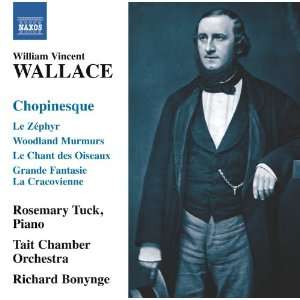|
Back
01/24/2013
William Vincent Wallace: Chopinesque: “Polonaise de Wilna” – “Nocturne Mélodique” – “La Sympathie - Valse” – “Le Zéphyr - Nocturne” – “Souvenir de Cracovie - Mazourka” – “Woodland Murmurs - Nocturne” – “Le Chant des Oiseaux - Nocturne pour le piano” – “Valse Brillante” – “Au bord de la mer - Nocturne” – “Varsovie - Mazourka pour le piano” – “Three Nocturnes, opus 20, No° 1” – “Souvenir de Naples - Barcarolle” – “La Brunette - Valse Brillante de Salon” – “Innocence - Romance” – “Victoire - Mazourka” – “La Grace - Nocturne” – “Grande Fantaisie La Cracovienne” (orch. Jeremy Silver)
Rosemary Tuck (Piano), Tait Chamber Orchestra, Richard Bonynge (Piano/Conductor)
Recording: Ford Abbey, Chard, Somerset, UK (March 6 and October 17-18, 2011) & St. Paul’s Knightbridge, London, UK (November 24, 2011) – 79’ 20
Naxos #8.572776 – Booklet in English

   
Ever since hearing Niccolò Paganini on violin, William Vincent Wallace wanted to emulate the Italian’s virtuosities as well as on piano. Early 19th century composers focused on Paris with more linear approach while William Vincent Wallace mapped a more circuitous and tad uncanny azimuth. His impetuous wanderlust took him to Tasmania, Australia, Chile, Jamaica and Mexico during which time he soaked up a mélange of cultures and rhythms.
Scoring success with his first opera, Maritana in 1845 and the subsequent premiere of Lurline in 1860 (beautifully captured by Naxos: Maritana (Read here) and Lurline (Read here), Wallace was also having triumphs on the keys depicting pieces accentuated with varying moods and nuances. Undoubtedly, Wallace’s cultural exposure paved a road of persuasive inculcations, and the public warmly received his works. The influences of Frédéric Chopin are convincing enough to have Naxos title this album Chopinesque due to the likeness in style and zest to the namesake.
The selection of works is a persuasive summary of Wallace’s life which Rosemary Tuck briskly unfurls with lyrical synchronization. Tuck masterfully unveils Wallace’s A-B-A format, well realized in several compositions such as in the vibrant waltzes (“Valse Brillante”, “La Brunette – Valse Brillante de Salon”, “La Sympathie – Valse”.) Wallace shines with jubilant musical imagery in his poetic sketches (“Le Chant des Oiseaux”, “Au bord de la mer” and “Le Zéphyr”), effervescent mazurkas (“Souvenir de Cracovie”, “Varsovie”, “Victoire”), pensive nocturnes, and an opening polonaise (“Polonaise de Wilna”) that’s introduced in somber, classical form, only to be suddenly transformed into a sheen of peppery limelight (Richard Bonynge performs this piece.) Tuck is accompanied by the Tait Chamber Orchestra in the conclusive “Grande Fantaisie La Cracovienne.” Albeit rather long, the music allows Tuck to amplify her talents through repeated variations with alternating melodic and harmonic lines featuring softened woodwinds, strings and horns.
Chopin’s resolute formality was in keeping with Parisian salon audiences. In contrast, Wallace relinquished this defined rigidness with a sassier atmosphere of color, frivolity, and lightheartedness. William Vincent Wallace’s piano compositions are filled with grandiloquent runs, coloratura-like passages and unexpected turns. Frédéric Chopin audiophiles who’d like a bit of an edge will find Rosemary Tuck’s Chopinesque pleasingly infectious.
Christie Grimstad
|